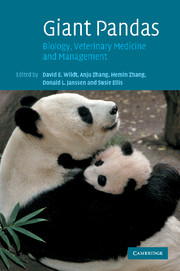Book contents
- Frontmatter
- Contents
- List of contributors
- Foreword
- Acknowledgements
- 1 The giant panda as a social, biological and conservation phenomenon
- 2 The Giant Panda Biomedical Survey: how it began and the value of people working together across cultures and disciplines
- 3 Factors limiting reproductive success in the giant panda as revealed by a Biomedical Survey
- 4 Significant medical issues and biological reference values for giant pandas from the Biomedical Survey
- 5 Life histories and behavioural traits as predictors of breeding status
- 6 Nutrition and dietary husbandry
- 7 Male reproductive biology in giant pandas in breeding programmes in China
- 8 Endocrinology of the giant panda and application of hormone technology to species management
- 9 The value and significance of vaginal cytology
- 10 Parentage assessment among captive giant pandas in China
- 11 The science of behavioural management: creating biologically relevant living environments in captivity
- 12 Evaluating stress and well-being in the giant panda: a system for monitoring
- 13 The neonatal giant panda: hand-rearing and medical management
- 14 Consequences of early rearing on socialization and social competence of the giant panda
- 15 Medical management of captive adult and geriatric giant pandas
- 16 Diseases and pathology of giant pandas
- 17 Ultrasonography to assess and enhance health and reproduction in the giant panda
- 18 Gastrointestinal endoscopy in the giant panda
- 19 Historical perspective of breeding giant pandas ex situ in China and high priorities for the future
- 20 Role and efficiency of artificial insemination and genome resource banking
- 21 Analysis of demographic and genetic trends for developing a captive breeding masterplan for the giant panda
- 22 Partnerships and capacity building for securing giant pandas ex situ and in situ: how zoos are contributing to conservation
- Index
- Plate Section
- References
22 - Partnerships and capacity building for securing giant pandas ex situ and in situ: how zoos are contributing to conservation
Published online by Cambridge University Press: 09 August 2009
- Frontmatter
- Contents
- List of contributors
- Foreword
- Acknowledgements
- 1 The giant panda as a social, biological and conservation phenomenon
- 2 The Giant Panda Biomedical Survey: how it began and the value of people working together across cultures and disciplines
- 3 Factors limiting reproductive success in the giant panda as revealed by a Biomedical Survey
- 4 Significant medical issues and biological reference values for giant pandas from the Biomedical Survey
- 5 Life histories and behavioural traits as predictors of breeding status
- 6 Nutrition and dietary husbandry
- 7 Male reproductive biology in giant pandas in breeding programmes in China
- 8 Endocrinology of the giant panda and application of hormone technology to species management
- 9 The value and significance of vaginal cytology
- 10 Parentage assessment among captive giant pandas in China
- 11 The science of behavioural management: creating biologically relevant living environments in captivity
- 12 Evaluating stress and well-being in the giant panda: a system for monitoring
- 13 The neonatal giant panda: hand-rearing and medical management
- 14 Consequences of early rearing on socialization and social competence of the giant panda
- 15 Medical management of captive adult and geriatric giant pandas
- 16 Diseases and pathology of giant pandas
- 17 Ultrasonography to assess and enhance health and reproduction in the giant panda
- 18 Gastrointestinal endoscopy in the giant panda
- 19 Historical perspective of breeding giant pandas ex situ in China and high priorities for the future
- 20 Role and efficiency of artificial insemination and genome resource banking
- 21 Analysis of demographic and genetic trends for developing a captive breeding masterplan for the giant panda
- 22 Partnerships and capacity building for securing giant pandas ex situ and in situ: how zoos are contributing to conservation
- Index
- Plate Section
- References
Summary
INTRODUCTION
The new information in this book is largely the product of a series of successful cross-cultural and biological experiments – that is, people with diverse backgrounds and skills working together over time to create scholarly information, which is already being used to enhance giant panda management. Much of the progress is the result of personal relationships that developed during the course of the Survey, which, in turn, provided some valuable lessons about working together in China. Among these is the importance of developing respectful, collegial partnerships. This does not mean a one-time meeting or research study but rather long-lasting relationships that are sustained over many years. This obviously requires substantial investments of time and money, and fierce commitments by all parties. In China, this also means the need for frequent face-to-face interaction.
Remarkably, all of this has transpired to benefit giant pandas, both ex situ and in situ. While this chapter briefly reviews why success occurred, its main purpose is to share new information about the larger impacts of these relationships. In particular, we examine how partnerships involving giant pandas are addressing one of China's most frequently identified needs – capacity building, thereby creating the next generation of skilled biologists and managers devoted to conserving Chinese wildlife and their habitats. Interestingly, zoos are a major force taking many of these steps forward.
WHY SUCCESS TO DATE?
There are three elements responsible for the significant increase in knowledge about giant panda biology, as follows.
- Type
- Chapter
- Information
- Giant PandasBiology, Veterinary Medicine and Management, pp. 520 - 540Publisher: Cambridge University PressPrint publication year: 2006
References
- 1
- Cited by



